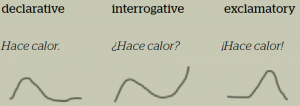5.3 Intonation

“Melodía cantando hombre”, Pixabay Open License.
In phonetics, intonation is the variation in pitch we create when we speak. Pitch varies according to the rate of vibration of the vocal folds, the faster the vibration, the higher the pitch. All languages use pitch for linguistic purposes. For example, pitch allows us to know whether an utterance is a declarative statement, a question, or an exclamation. In order to acquire the right intonation in Spanish, it is important to understand the pitch contour that runs through a phrase.
In the graphic below, you can observe the pitch contours of the three kinds of phrases we will discuss in this chapter. Please listen to these phrases in the order they appear in the illustration: 1) “Hace calor.” 2) “¿Hace calor?” 3) “¡Hace calor!”

As you heard in the example above, declarative phrases in Spanish and English have a falling contour. Interrogative phrases (questions) contain a wider pitch range than that of declarative phrases. We will consider two types: yes/no questions and question-word questions. For yes/no questions, an English speaker has three ways to indicate that her utterance is a question: intonation, subject-verb inversion, and the use of an auxiliary verb. Fred is tall vs. Is Fred tall? Martha speaks Spanish vs. Does Martha speak Spanish? In Spanish, however, intonation is the only linguistic feature that allows the speaker to differentiate between a statement and a question. That is why it is very important that an English speaker learn the right intonation in Spanish. Question-word questions have a falling contour in Spanish, just like declarative phrases, but here the highest pitch point falls on the question word. Listen to these two examples: “¿Dónde está mi camisa?” “¿Qué quieres hacer hoy?”
The overview of intonation we have presented here refers to utterances that are made in a neutral way. In the cases where there is an added pragmatic meaning like sarcasm, irony, politeness or insistence, to name a few, the pitch contour can vary greatly. However, it is not within the scope of this book to address such intricacies.
Discrimination exercise. Listen to the recording and indicate whether the phrases are declarative, interrogative, or exclamatory.

